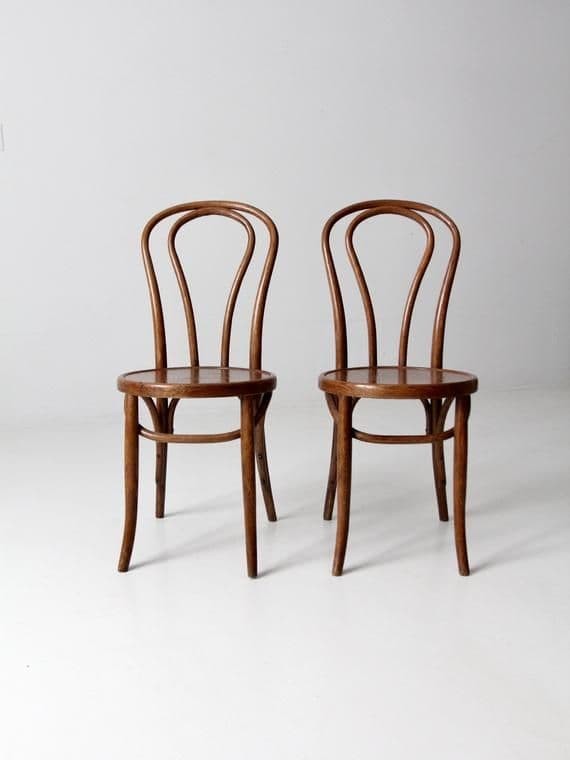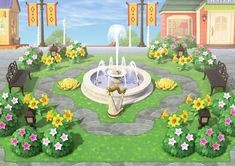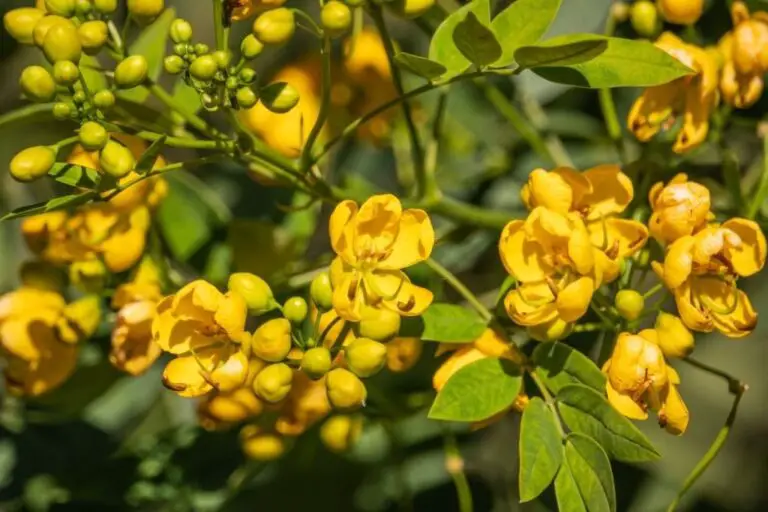25 Different Types Of Bamboo Plants For Landscaping (With Pictures)
Are you ready to bring a touch of the exotic into your home? Look no further than bamboo! With over 25 unique types to choose from, each with its own distinct characteristics and benefits, you’re sure to find one that fits your style. In this post, we’ll explore the fascinating world of bamboo plants, covering everything from their pros and cons to how to care for them.
Whether you’re a seasoned gardener or just starting out, you’ll find inspiration in our comprehensive guide to the many wonders of bamboo.
How many types of bamboo plants are there?
Bamboo’s vast diversity may come as a shock – there are over 1,200 species of this fast-growing grass! Native to regions across Asia, Africa, and South America, bamboo plants exhibit an astonishing range of sizes and shapes. From miniature varieties to towering giants reaching up to 100 feet tall, the sheer variety is impressive. The different types of bamboo can be broadly categorized into two main groups: running bamboo and clumping bamboo.
Running bamboo spreads aggressively through underground rhizomes, making it challenging to manage as the rhizomes rapidly invade other areas of your garden. In contrast, clumping bamboo grows in tight clusters, offering a much more manageable option.
Types of bamboo plants
With a staggering number of over 1,200 species, bamboo plants exhibit remarkable diversity in terms of shape and size. Their global distribution is equally impressive, with these versatile plants found on every continent. From the diminutive to the majestic, bamboo plants can range from just six inches tall to towering heights of up to 100 feet.
Furthermore, some species boast leaves that reach an astonishing two feet in length, underscoring the incredible adaptability and variety of this remarkable plant family.
Black Bamboo (Phyllostachys nigra)
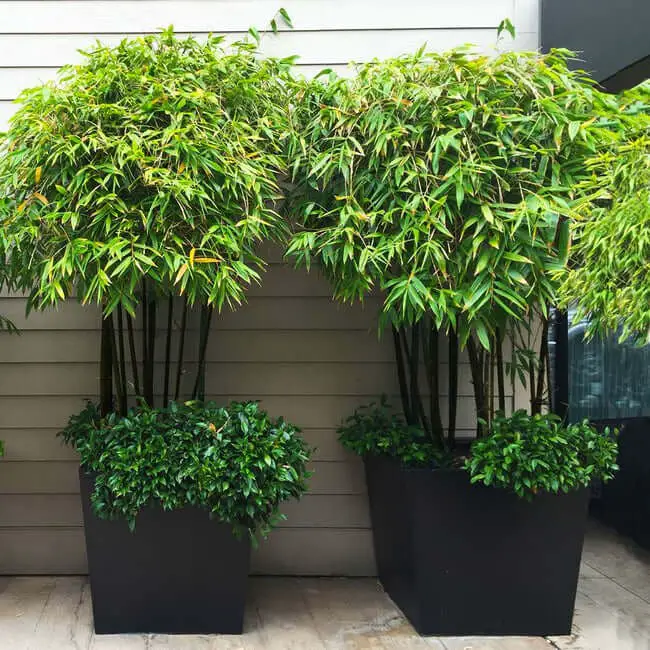
Black Bamboo, a species of bamboo native to China, has been utilized for centuries as both a food and material source. Reaching heights of 30-40 feet (91-122 cm), the plant’s distinctive black stems and leaves give it its name. The hollow culms can be employed as pipes or tubes, highlighting the versatility of this fast-growing plant.
With the ability to produce up to 30 new shoots per season, Black Bamboo is a thriving species that has also been used in traditional Chinese medicine for its medicinal properties. Additionally, the plant serves as an ornamental feature in gardens and parks, further solidifying its diverse range of uses. As a food source, material source, or ornamental plant, Black Bamboo’s adaptability has made it a valuable component of various contexts.
Buddha Belly Bamboo (Bambusa ventricosa)
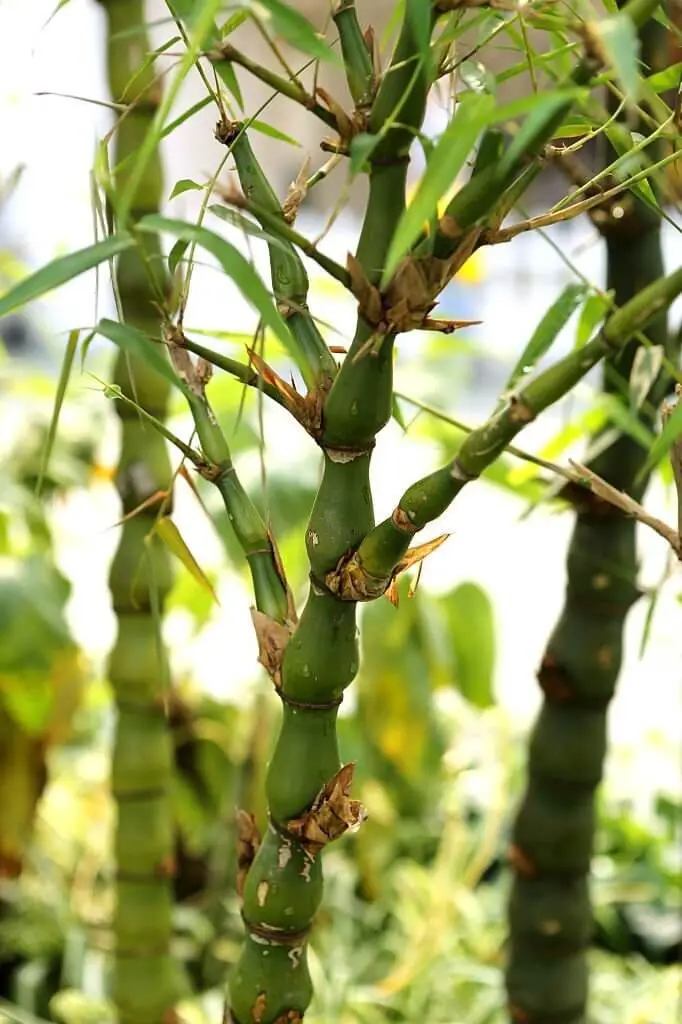
Buddha Belly Bamboo, scientifically known as Bambusa ventricosa, is an evergreen perennial that thrives in Asia. This species of flowering plant in the Poaceae family has been cultivated for centuries due to its versatility and numerous uses. Not only does it produce edible shoots, but its timber is also highly prized. Additionally, traditional medicine practitioners have long harnessed the plant’s potential, incorporating it into their treatments.
With a remarkable ability to grow up to 15 meters in height, this fast-growing plant has become an integral part of Asian ecosystems.
Chilean Bamboo (Chusquea culeou)
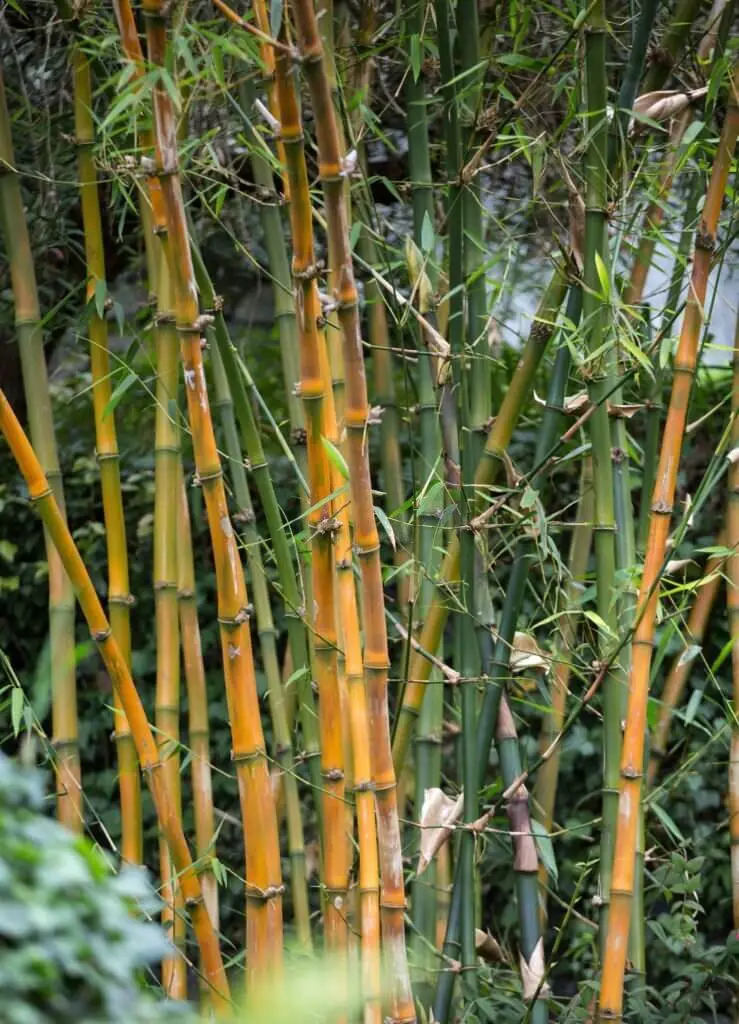
In Chile, there’s a remarkable plant species known as Chilean Bamboo or ‘Culeu’. This evergreen perennial can reach impressive heights of up to 30 meters and diameters of 12 centimeters, making it the largest and most widespread bamboo species in the country. The leaves are long and slender, measuring up to 25 centimeters in length and just 0.75 centimeters wide. When flowers do bloom, they’re small and green, appearing on short inflorescences that emerge from the nodes of the culms.
Fruit-wise, Chilean Bamboo produces small black berries, roughly 0.75 centimeters in diameter, each containing two seeds.
Chinese Fountain Bamboo (Fargesia nitida)
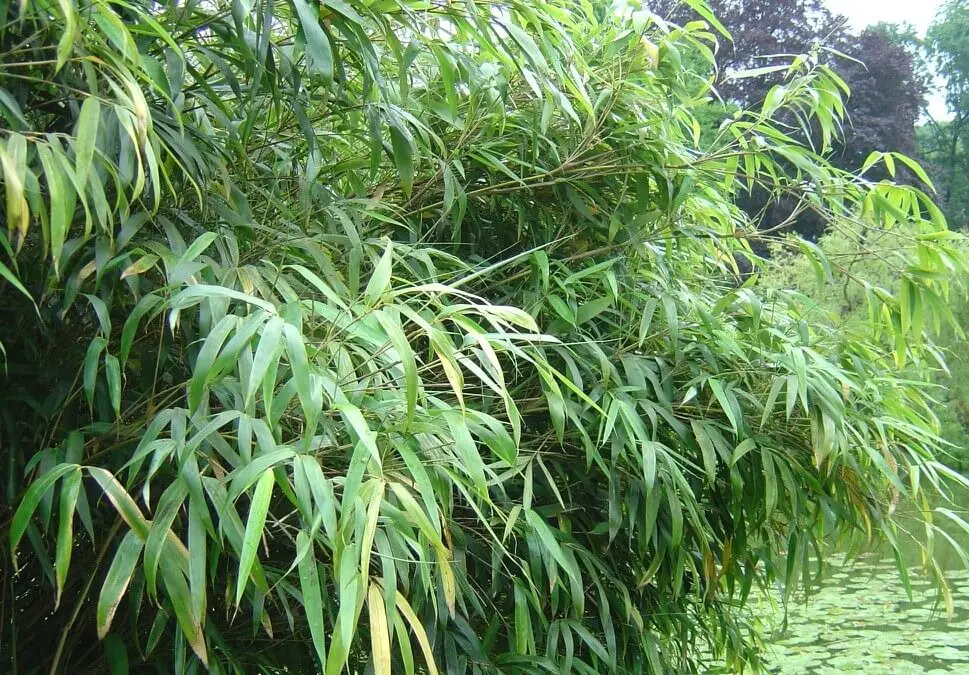
Chinese Fountain Bamboo, a species native to China, boasts a unique blend of utility and aesthetic appeal. This versatile plant has been utilized in traditional Chinese medicine for its medicinal properties and as an ornamental feature in gardens and landscapes. The plant’s leaves display a striking combination of dark green and glossy upper surfaces with a subtle purple undertone on the underside. As the culms mature, they transition from green to a warm yellow-brown hue.
Rarely flowering, the plant’s small white blooms are a fleeting yet charming sight when they do appear. Its attractive foliage and slender growth habit have earned Chinese Fountain Bamboo popularity as an ornamental choice. Moreover, its leaves are used in traditional Chinese medicine, where they’re boiled in water to create a soothing tea.
Chinese Mountain Bamboo (Bashania fargesii)
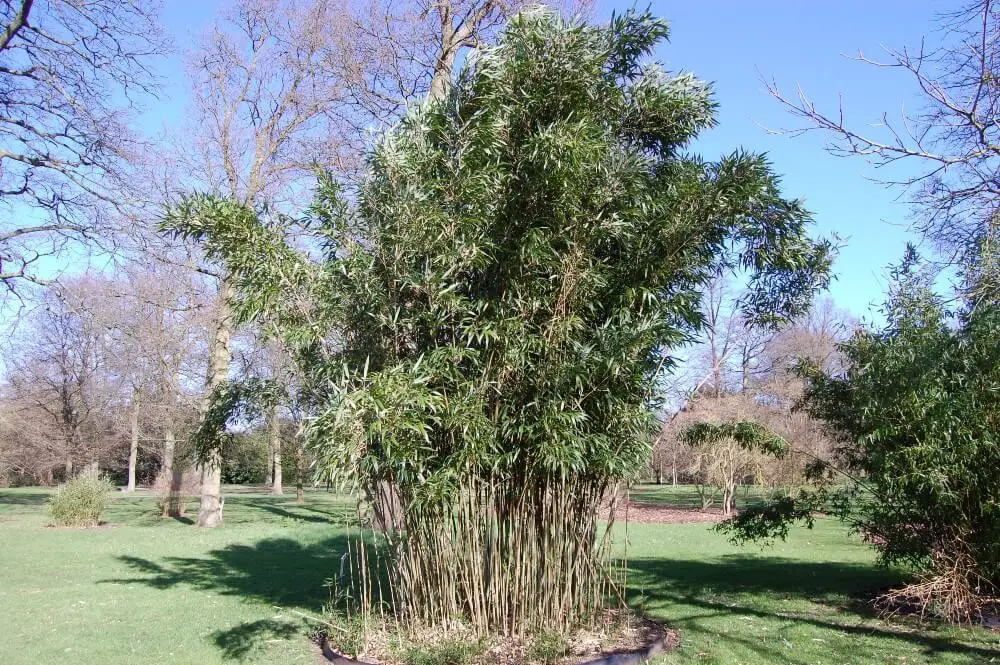
Chinese Mountain Bamboo (Bashania fargesii) is a striking species of bamboo that calls the mountains of China home. Reaching heights of around 30 feet, its culms are roughly an inch in diameter, while its sprawling leaves can stretch up to 18 inches long and 12 inches wide. Notably resilient, this hardy bamboo can withstand temperatures as low as -20 degrees Fahrenheit, making it an ideal choice for landscaping purposes.
Its versatility has earned it a reputation as a popular privacy screen or hedge, and its beauty is undeniable. With its striking appearance, impressive durability, and adaptability to various landscapes, Chinese Mountain Bamboo is an excellent addition to any outdoor space.
Dragon Head Bamboo (Fargesia rufa)
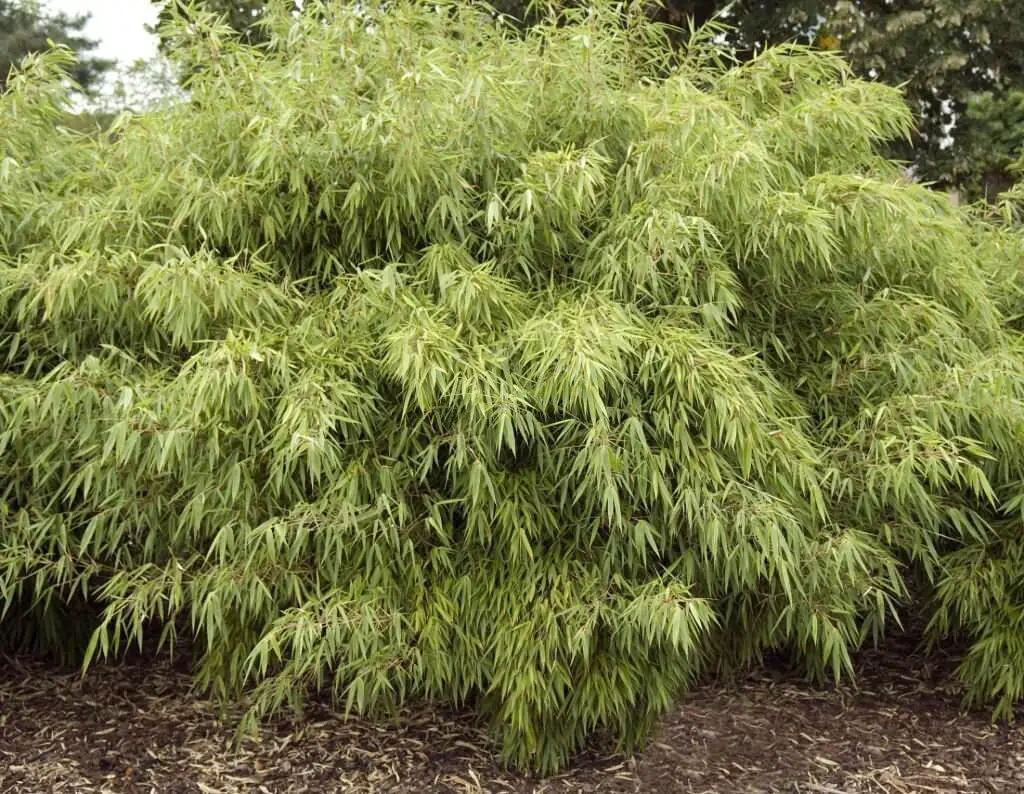
Dragon Head Bamboo (Fargesia rufa) is a perennial evergreen native to central China, boasting impressive dimensions: it grows up to 15 meters tall and 0.45 meters broad, with arching culms and roots that form clumps measuring several meters wide. The leaves are lance-shaped, reaching 20-30 centimeters in length and 0.75-1.5 centimeters in width, featuring a pointed tip. These leaves serve as the backdrop for the plant’s unique flowers, which appear in panicles 15-35 centimeters long.
Each flower is bisexual and has a yellowish-green hue, blooming on the lower nodes of the culm. The fruit takes the form of a caryopsis. When it comes to its growing conditions, Fargesia rufa is surprisingly resilient, tolerating frost down to USDA hardiness zone and thriving in full sun to partial shade, with moist, well-drained soils being its ideal environment. Propagation can be achieved through division in spring or early summer.
Dwarf Green Stripe Bamboo (Pleioblastus viridistriatus ‘Dwarf Greenstripe’)
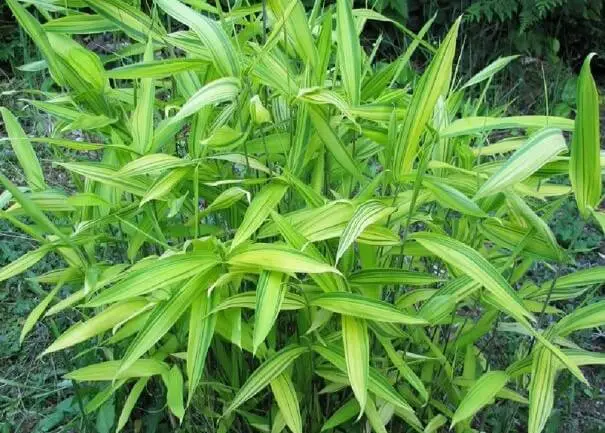
In Walmart’s online store, you can purchase the striking Dwarf Green Stripe Bamboo, a native Chinese species that has gained popularity due to its compact size and vibrant green and yellow striped foliage. This bamboo variety reaches approximately 15 feet (45 cm) in height and spreads around 12 feet (36 cm) wide, making it an ideal choice for landscaping.
The leaves measure about two inches (five cm) across and showcase a striking pattern of green and yellow stripes, while the culms (stems) are similarly striped with a diameter of roughly one inch (two cm). Notably, Dwarf Green Stripe Bamboo is not frost-hardy and thrives in areas that do not experience frost. It prefers full sun to partial shade and well-drained soil for optimal growth.
This versatile bamboo can be propagated via rhizome cuttings or seed, growing rapidly but potentially becoming invasive if not properly managed. As a result, it’s commonly used in landscaping and as a container plant.
Edible Bamboo Plant (Dendrocalamus strictus)
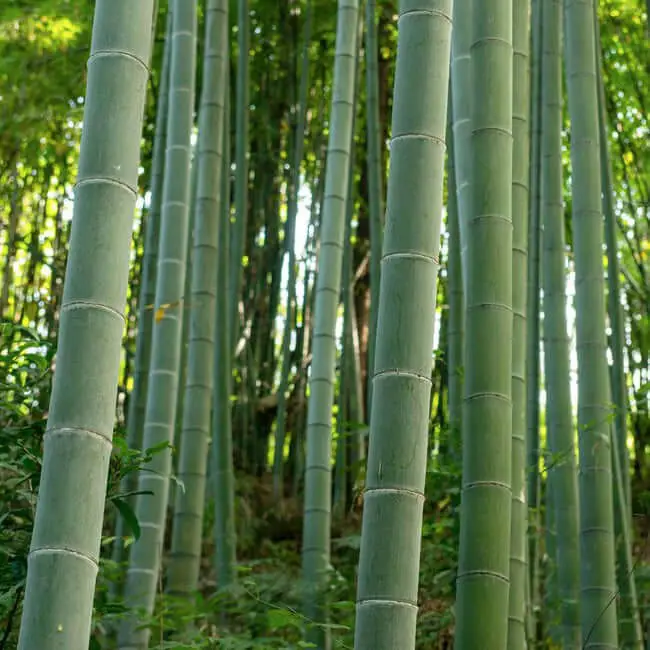
Edible Bamboo Plant is a species of bamboo that originates from Southeast Asia, where it’s cultivated extensively. This plant also goes by other common names such as Chinese Bamboo, Malaysian Bamboo, and Thai Bamboo, signifying its widespread cultivation across the region. As part of the Bambusoideae subfamily and Bambuseae tribe, Edible Bamboo Plant is a unique species with distinct characteristics. Standing tall at 20-30 meters in height and 0.60-0.
90 meters in diameter, this plant boasts straight and cylindrical culms (stems) with closely spaced nodes (joints). The leaves of the Edible Bamboo Plant are lanceolate, measuring 20-40 centimeters long and half as wide, featuring finely serrated margins that give them a unique texture.
Fernleaf Bamboo (Bambusa multiplex ‘Fernleaf’)
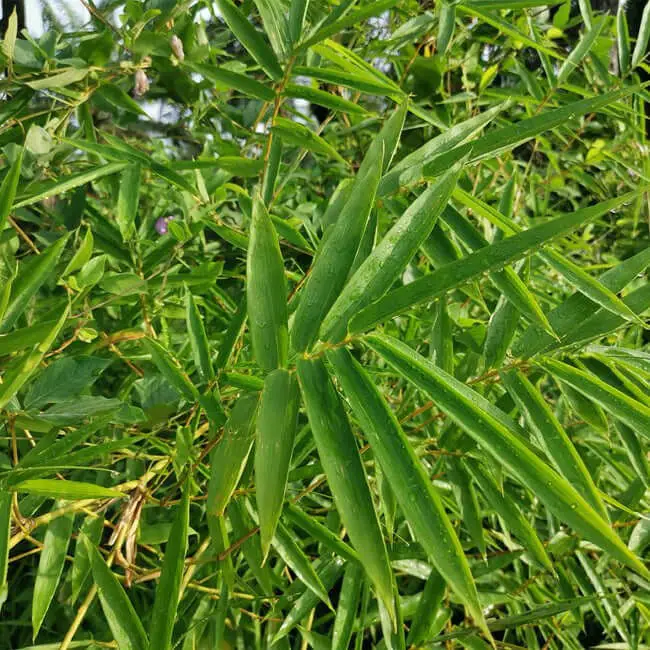
Fernleaf Bamboo stands out with its impressive growth rate, reaching heights of 15-20 feet tall. Its slender, green culms showcase prominent yellow stripes, while the large, dark green leaves boast a fern-like appearance reminiscent of a lush forest floor. Native to China and Japan, this adaptable species can thrive in most temperate climates, making it an attractive option for gardeners seeking to create a sense of seclusion with its dense foliage.
Whether used as a privacy hedge or ornamental plant, Fernleaf Bamboo’s versatility is undeniable.
While relatively low-maintenance, this bamboo does require consistent watering and fertilization to sustain its rapid growth rate. With the right care, however, Fernleaf Bamboo can become a stunning addition to any landscape.
Fish Pole Bamboo (Phyllostachys aurea)
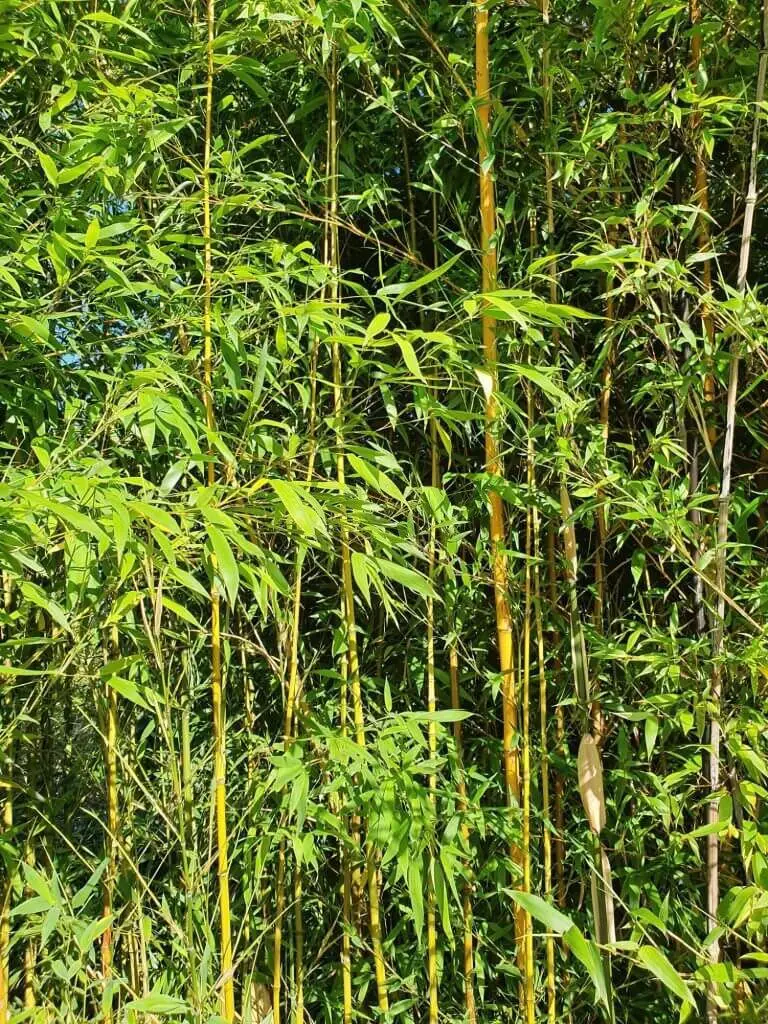
Fish Pole Bamboo, also known as Golden Bamboo, is a species of bamboo native to China, where it’s widely cultivated alongside Japan, Korea, and the United States. This versatile plant grows up to 30 feet tall, with sturdy culms that can reach two inches in diameter, boasting a vibrant yellow-gold hue and a smooth, glossy finish. Its leaves are large and ovate, featuring serrated edges that provide a unique texture.
Infrequent flowering is characteristic of Fish Pole Bamboo, resulting in small, greenish-white blooms that typically emerge during the summer months. Following this rare display, the plant produces small, black fruits containing viable seeds, allowing for successful propagation.
Giant Bamboo (Dendrocalamus giganteus)
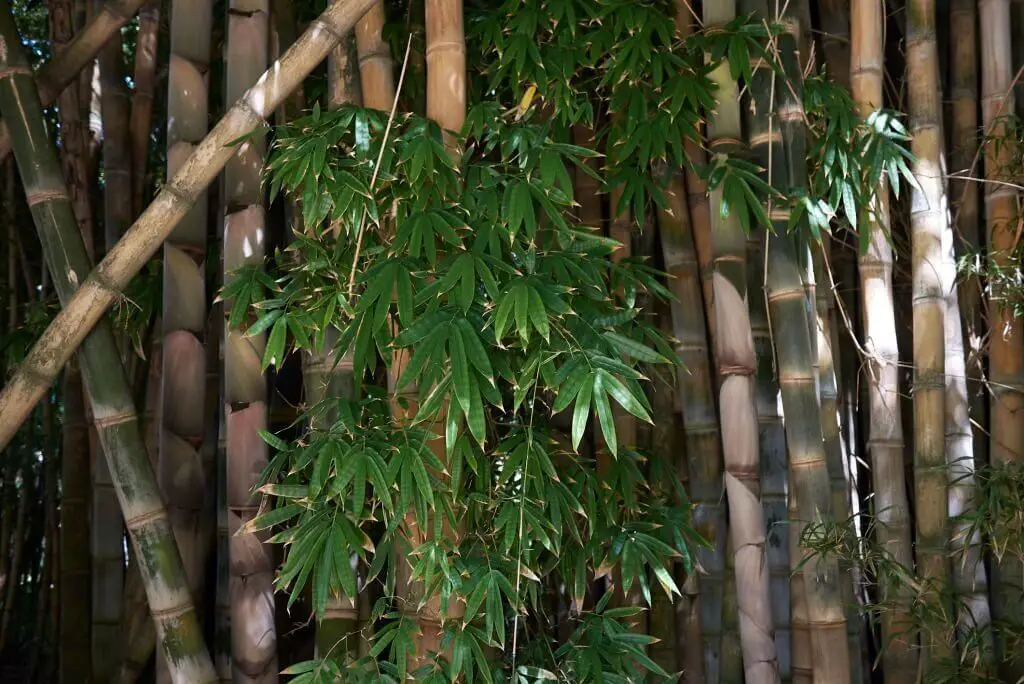
Giant Bamboo (Dendrocalamus giganteus) stands out as the world’s tallest species of bamboo, reaching dizzying heights of up to 30 meters. Native to India, Nepal, Bhutan, and China, this remarkable plant thrives in its natural habitat, producing culms that can grow up to 15 centimeters in diameter and reach lengths of up to 100 feet. Its impressive foliage is equally notable, with leaves measuring up to 30 centimeters long and 12 centimeters wide.
Small, white flowers bloom during the summer months, adding a touch of elegance to the plant’s already-striking appearance. Giant Bamboo is renowned for its remarkable growth rate – it can reach maturity in just a few years – making it an attractive choice for ornamental purposes or construction projects. The plant also has a long history of use in traditional medicine, with practitioners valuing its unique properties and benefits.
One of the most compelling aspects of Giant Bamboo is its adaptability. Whether you’re looking to add some drama to your landscape design, construct something sturdy, or harness its medicinal properties, this remarkable species has something to offer. Its impressive height and rapid growth rate make it an ideal choice for anyone seeking a versatile and fast-growing plant.
Golden Bamboo (Bambusa multiplex ‘Golden Goddess’)
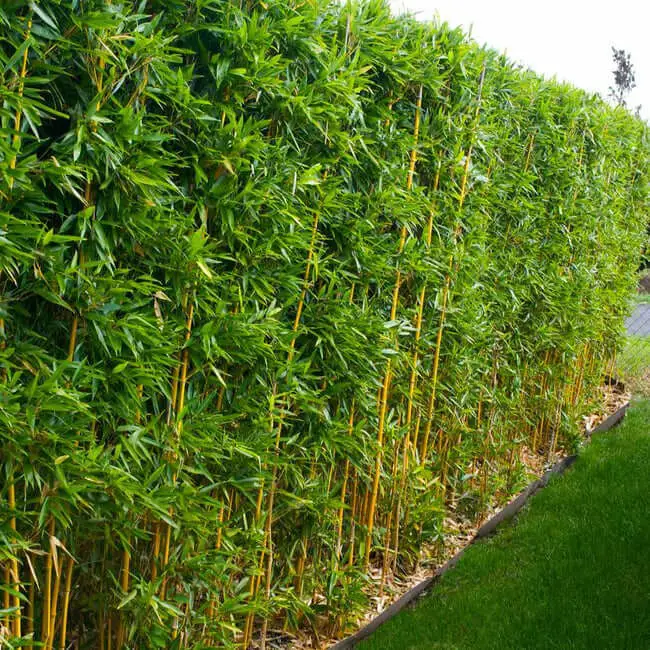
With its rapid growth rate and stunning appearance, Golden Bamboo is an excellent choice for adding a touch of tropical flair to any outdoor space. Its versatility makes it ideal for creating privacy screens, hedges, or windbreaks, while also thriving in containers or as an accent plant. This heat-tolerant and drought-resistant bamboo can thrive in full sun to partial shade and well-drained soils.
Unlike some other types of bamboo, Golden Bamboo is a clumping variety that won’t spread invasively, reaching heights of 20-30 feet with culms up to an inch in diameter. The striking combination of golden yellow culms adorned with green stripes, coupled with dark green and glossy leaves, makes this relatively new addition to the market a sure showstopper for any garden.
Green-Glaucous Bamboo (Phyllostachys viridiglaucescens)
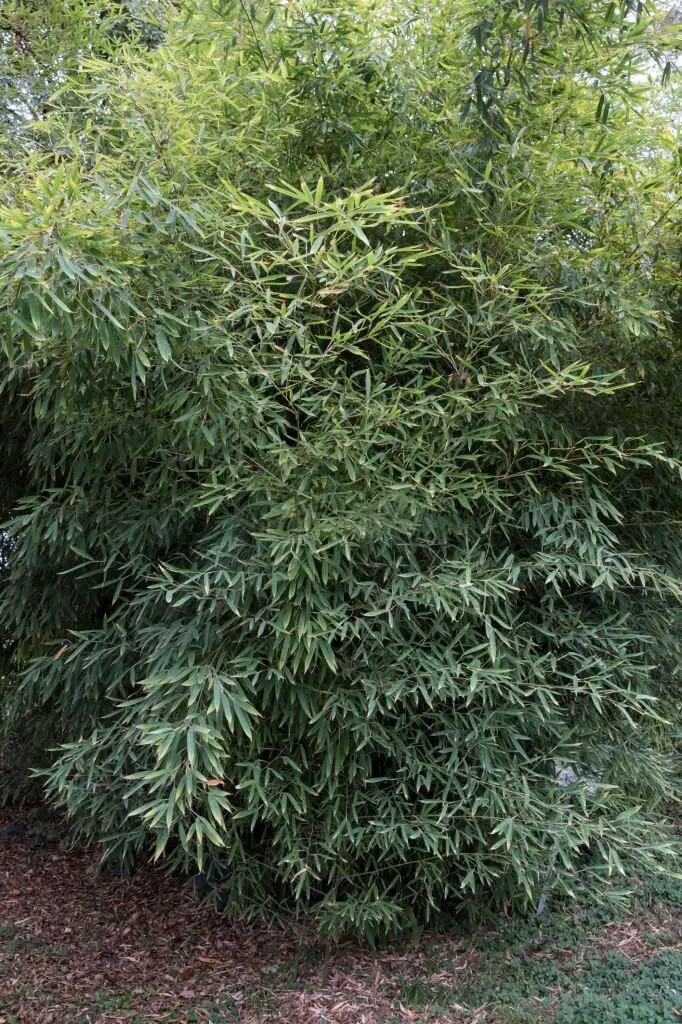
Green-Glaucous Bamboo, a species of flowering plant in the family Poaceae, is native to China. Its striking blue-green stems and foliage make it a popular ornamental plant in temperate regions. The plant can grow up to 20 meters tall with a diameter of up to 12 centimeters. Its erect, straight, and smooth culms feature nodes that range from green to blue-green in color. The leaves are alternate, lance-shaped, measuring between 20-30 centimeters in length and 15 centimeters in width.
In the summer, small yellowish-white flowers appear in panicles or clusters, adding a touch of vibrancy to the plant’s overall appearance.
Guadua Bamboo (Guadua angustifolia)
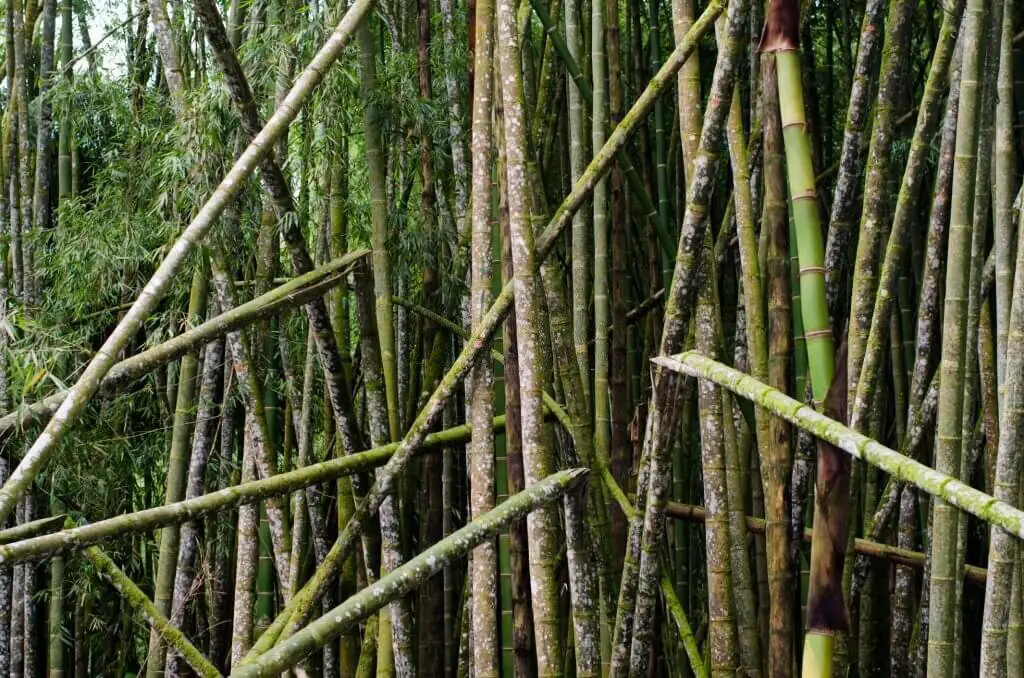
Guadua Bamboo, also referred to as Giant Bamboo, is a species of bamboo that thrives in Colombia, Ecuador, Panama, and Venezuela. This remarkable plant can reach astonishing heights of up to 30 meters (98 feet) with a diameter of up to 25 centimeters (10 inches). Its impressive stature belies its incredible strength – Guadua Bamboo is widely regarded as the strongest type of bamboo globally.
For centuries, it has been employed in construction projects, and its versatile nature also makes it suitable for crafting furniture, musical instruments, and paper. Notably, Guadua Bamboo can be harvested within a remarkably short period of just three years, making it an attractive option for those seeking to capitalize on this fast-growing plant’s bounty.
Furthermore, Guadua Bamboo has the potential to play a crucial role in combatting climate change by sequestering carbon dioxide and producing oxygen, making it an ideal candidate for reforestation initiatives. Additionally, its ability to prevent soil erosion and facilitate the creation of biodegradable products further underscores its value as a sustainable resource.
Japanese Arrow Bamboo (Pseudosasa japonica)
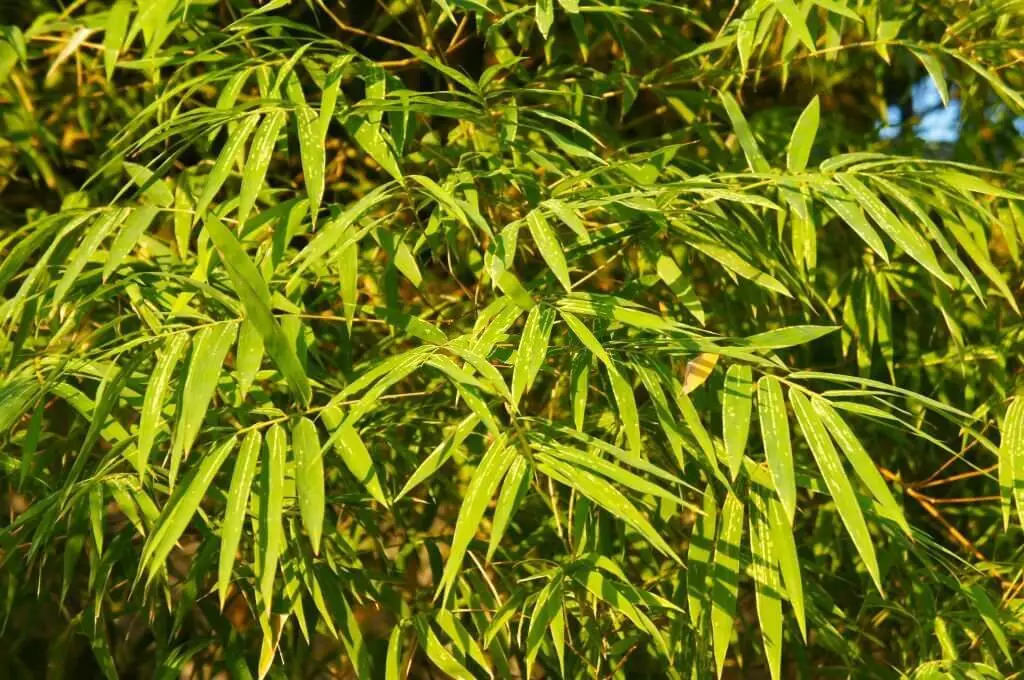
Japanese Arrow Bamboo, also known as Japanese Sasa, Hardy Bamboo, or simply Arrow Bamboo, is a species of bamboo that originates from East Asia. This versatile plant has earned its popularity for being used not only as an ornamental feature in gardens and parks but also in traditional medicine and as a food source. Standing tall at 20-30 feet (0.61-0.91 m) with culms (stems) measuring between 0.
75-11 inches (19-279 mm) in diameter, this plant boasts ovate to lanceolate leaves that can reach up to 12 inches (300 mm) long and four inches (100 mm) wide. In the summer months, white or greenish-white flowers bloom, adding a touch of beauty to its surroundings. Japanese Arrow Bamboo is an incredibly hardy plant capable of thriving in a wide range of conditions.
Preferring full sun to partial shade and moist to wet soil, it can also tolerate drought and salt spray, making it suitable for boggy areas as well.
Japanese Timber Bamboo (Phyllostachys bambusoides)
Japanese Timber Bamboo is a remarkable species that hails from China and Japan. Its towering height of up to 30 meters makes it the tallest member of the Phyllostachys genus, boasting an impressive stature. The characteristic yellowish-green culms feature striking dark green stripes, adding to its unique appeal.
The leaves of Japanese Timber Bamboo are ovate-lanceolate in shape, measuring 20-30 centimeters in length and 12-18 centimeters in width.
The flowers are a subtle greenish-white hue, arranged in panicles that stretch up to 40 centimeters long. This species has gained widespread cultivation as an ornamental plant in temperate regions worldwide.
Japanese Timber Bamboo is known for its rapid growth rate, reaching its full height within just four years. Its impressive strength and durability have made it a popular choice for construction, furniture-making, and even bamboo fencing, where the culms can grow up to 30 meters tall.
Moso Bamboo (Phyllostachys edulis)
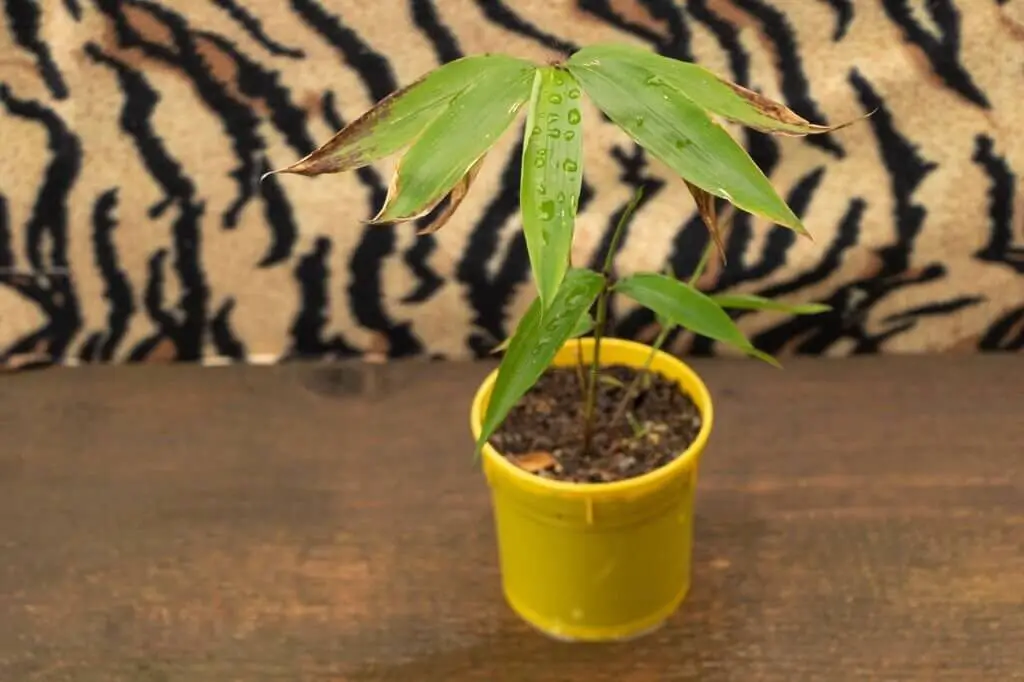
Moso Bamboo stands out as the largest and most economically significant species within the Phyllostachys genus, native to China where it has been a staple for centuries. Not only is it a vital food source, but its timber also holds great value. The stems of Moso Bamboo can reach remarkable heights of up to 30 meters in length, with diameters stretching as wide as 15 centimeters.
Multiplex Bamboo (Bambusa multiplex)
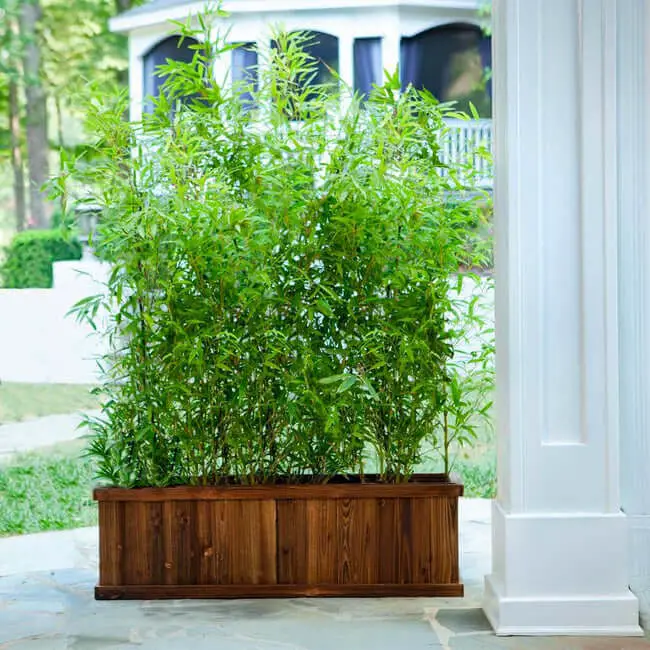
Multiplex Bamboo, native to East Asia, is widely cultivated in China, Japan, and Korea. It has also naturalized in the Philippines and Vietnam. This species of bamboo grows up to 15-25 meters tall and 0.30-0.60 meters wide, with straight culms featuring a yellow-green or greenish-yellow hue. Its lanceolate leaves measure between 20-35 centimeters long by 0.80-1.5 centimeters wide. Interestingly, the Multiplex Bamboo only flowers every three to six years, producing both male and female blooms.
Male flowers are found on racemes measuring 15-20 centimeters long, while female flowers appear on spikes reaching 20-25 centimeters in length.
Painted Bamboo (Bambusa vulgaris ‘Vittata’)
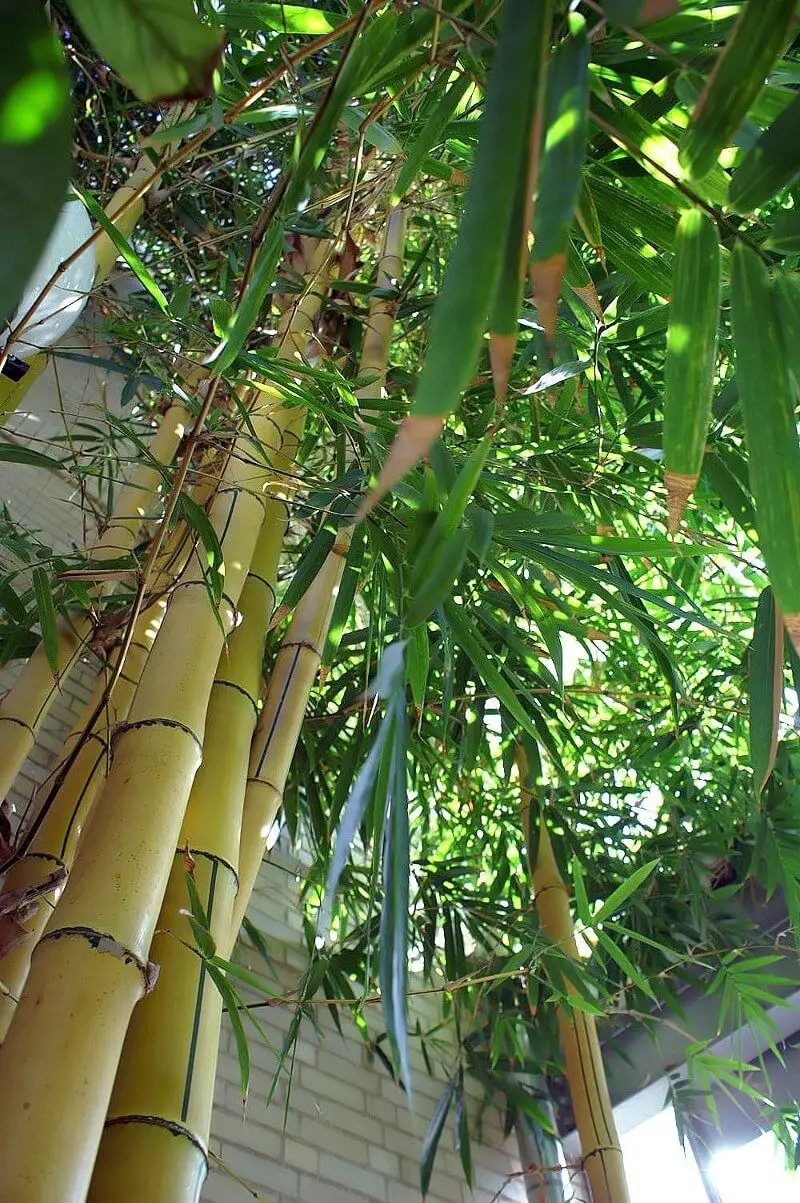
With its vibrant yellow and green striped culms, Painted Bamboo is a standout among the bamboo family. This fast-growing species can reach impressive heights of up to 30 feet, making it an excellent choice for adding visual interest to large outdoor spaces. Native to China and Taiwan, Painted Bamboo has a rich cultural heritage and is often sought after for its ornamental value.
Its adaptability is another major selling point – it can be used to create stunning privacy screens, block harsh winds, or even help control soil erosion. Whether you’re looking for a dramatic focal point or a practical solution for your outdoor space, Painted Bamboo is definitely worth considering.
Red Margin Bamboo (Phyllostachys rubromarginata)
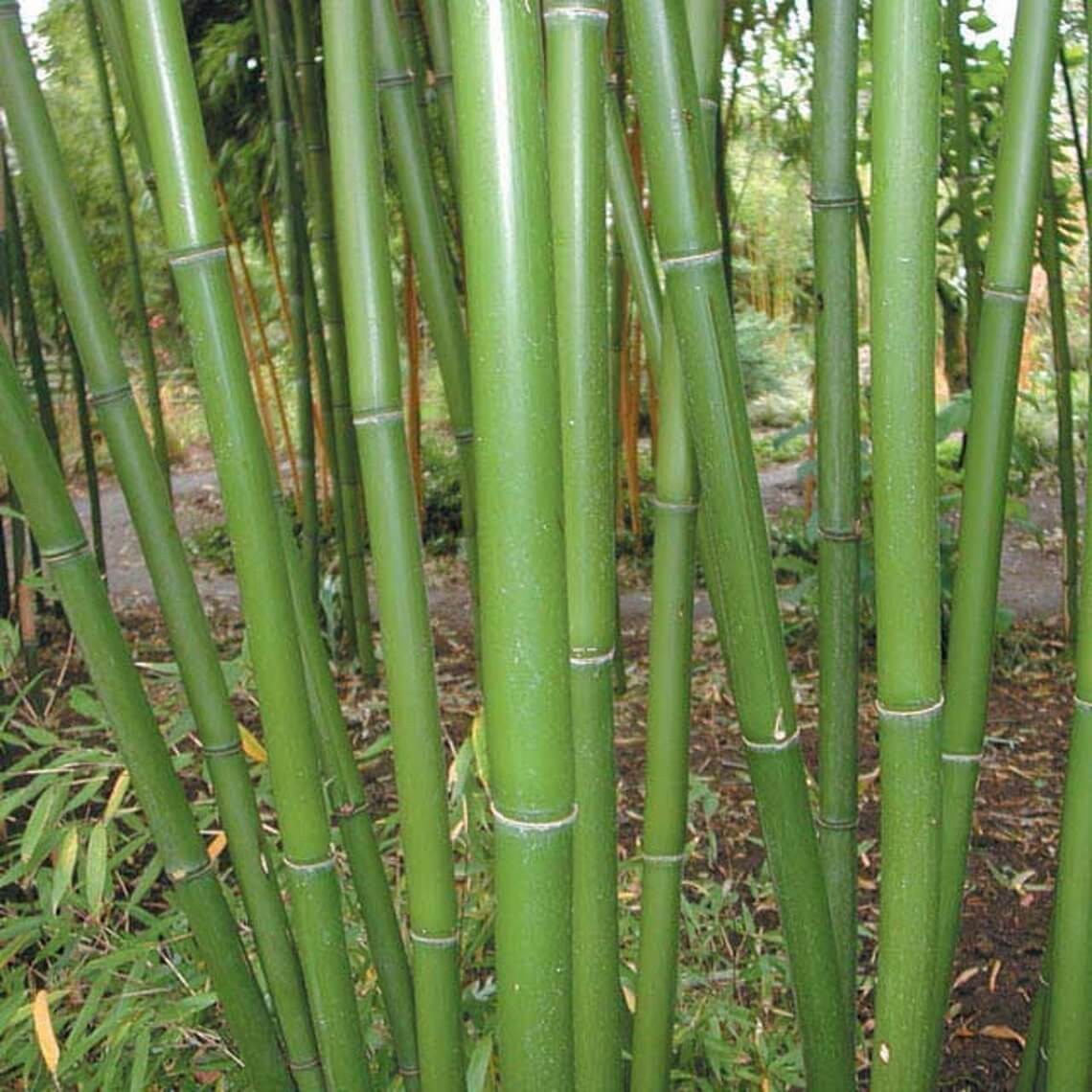
Etsy shoppers, get ready to discover a fascinating plant from China! Red Margin Bamboo is a unique species that boasts striking features. Its culms (stems) reach up to 15-20 meters in height and 12 cm in diameter, while its leaves are a vibrant green with distinctive red margins. The white flowers grow in clusters, and the spherical fruit is a deep black color.
This remarkable plant has multiple uses – it’s employed in traditional Chinese medicine, serves as an ornamental plant, and provides sustenance for pandas. Moreover, Red Margin Bamboo is used in construction projects and offers a valuable source of food for these beloved bears. When it comes to growing conditions, this species thrives in moist, shady areas with ample water supply. However, it’s crucial to note that Red Margin Bamboo is frost-sensitive and doesn’t tolerate prolonged droughts.
This fast-growing plant can spread rapidly, earning it the reputation as an invasive species in certain regions, such as Australia, where it has been introduced.
Rufa Bamboo Plant (Fargesia rufa)
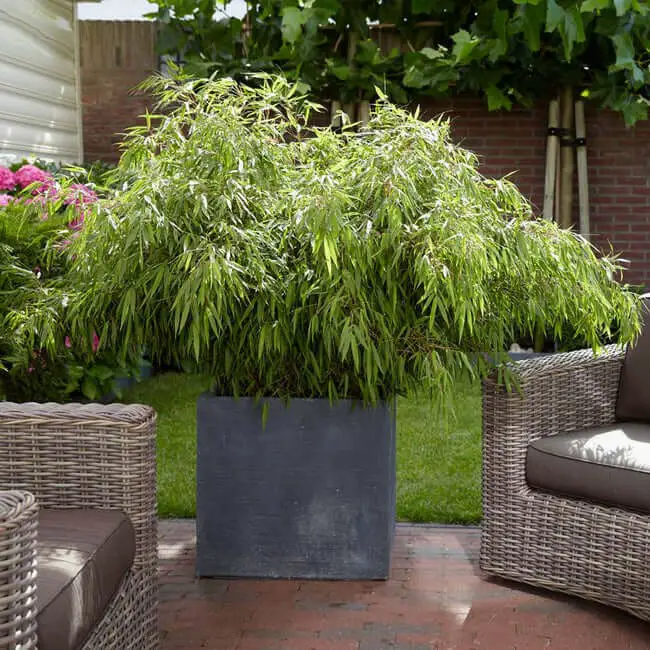
With its striking bluish-green color and rapid growth rate, the Rufa Bamboo Plant is a standout species within the Poaceae family. Native to southwestern China and southeastern Tibet, this bamboo can grow up to 15 meters tall, with sturdy culms reaching diameters of up to 35 centimeters. Its impressive height and robust stem have made it a popular choice for erosion control on hillsides and riverbanks.
The plant’s leaves are slender and elongated, measuring between 20-35 centimeters in length and roughly half as wide. Furthermore, the tiny greenish-white flowers are arranged in panicles that can reach lengths of up to 25 centimeters.
Slender bamboo (Bambusa textiles)
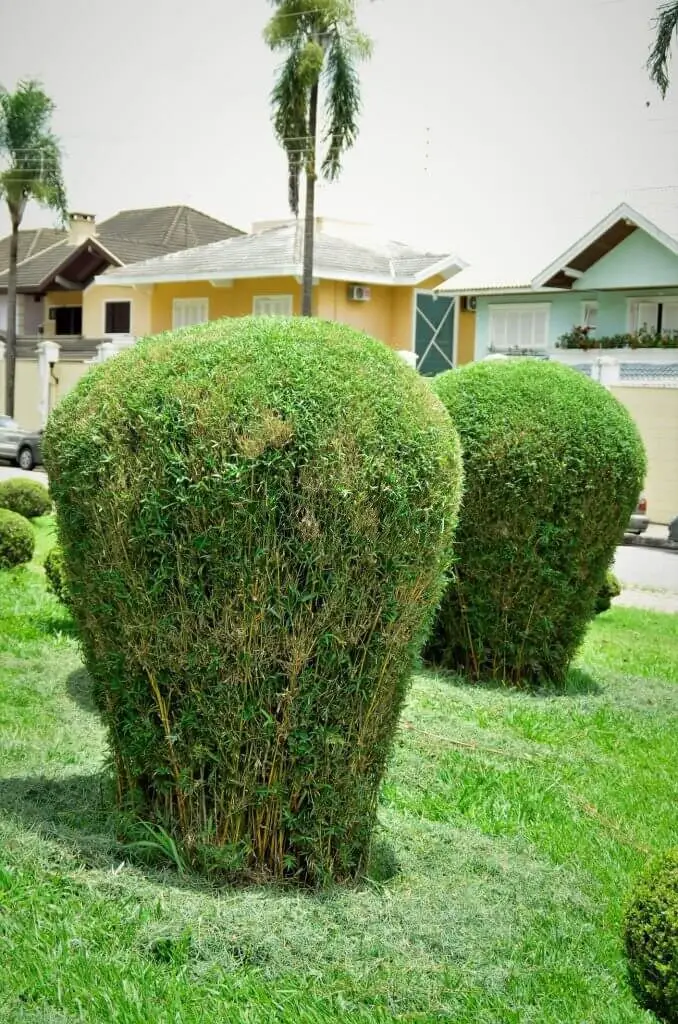
Slender bamboo, a species native to southern China and Taiwan, has gained popularity worldwide due to its adaptability and versatility. It thrives in various countries, including Japan, India, Sri Lanka, Myanmar, Thailand, Vietnam, Cambodia, Laos, Nepal, and the Philippines. The plant’s physical characteristics are equally impressive, with mature culms reaching up to 30 meters tall and 20-25 millimeters in diameter, while leaves stretch 20-30 centimeters long with a lanceolate shape.
Furthermore, white flowers bloom in panicles as long as 60 centimeters, producing black berries that house two seeds each. Beyond its aesthetic appeal, slender bamboo has significant cultural and practical value. In traditional Chinese medicine, the young shoots are employed to alleviate diarrhea, dysentery, and other digestive issues. The leaves find use in treating skin diseases, while fruits treat fever.
Additionally, slender bamboo is a valuable resource for construction, furniture-making, paper production, and as a food source.
Sunset Glow Bamboo (Fargesia rufa)
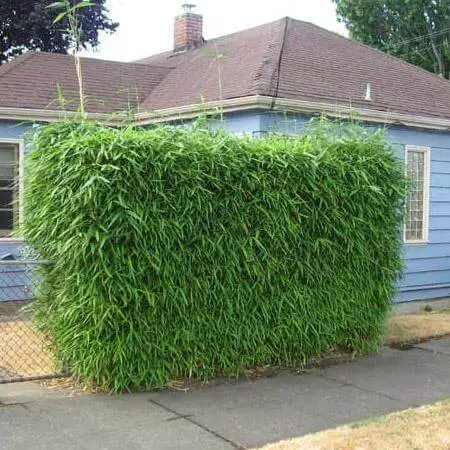
Indulge in the serene beauty of Sunset Glow Bamboo, a striking and resilient addition to any garden. Thriving in conditions ranging from full sun to partial shade, this bamboo variety excels in moist, well-drained soil. Its impressive growth rate allows it to reach towering heights of up to 20 feet, while its green culms adorned with yellow stripes add visual appeal.
As a bonus, the bamboo produces stunning white flowers during the summer months, creating a picturesque scene that’s sure to delight.
Timor black bamboo (Bambusa lako)
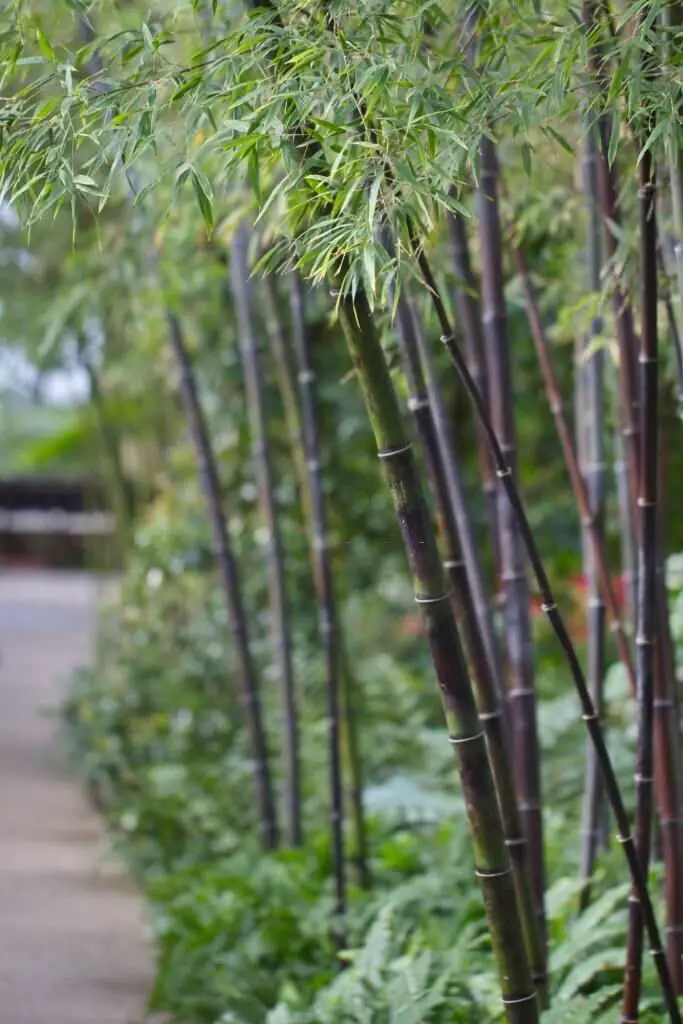
Timor black bamboo is a striking species within the Bambusoideae subfamily. Its origins are rooted in Timor, an Indonesian archipelago island. Characterized by its impressive stature, this type of bamboo can grow up to 20-30 meters (66-98 feet) tall, with robust culms featuring a diameter of as much as 15 centimeters (59 inches). The hollow culms exhibit spaced nodes, approximately every 15 centimeters (59 inches), adding to their unique appearance.
The leaves of Timor black bamboo are lanceolate in shape, measuring between 20-30 centimeters (79-12 inches) in length and about half that width. Notably, the plant’s inflorescence takes the form of a panicle, comprising up to 40 branches, each adorned with several small flowers.
Umbrella Bamboo (Fargesia murielae)
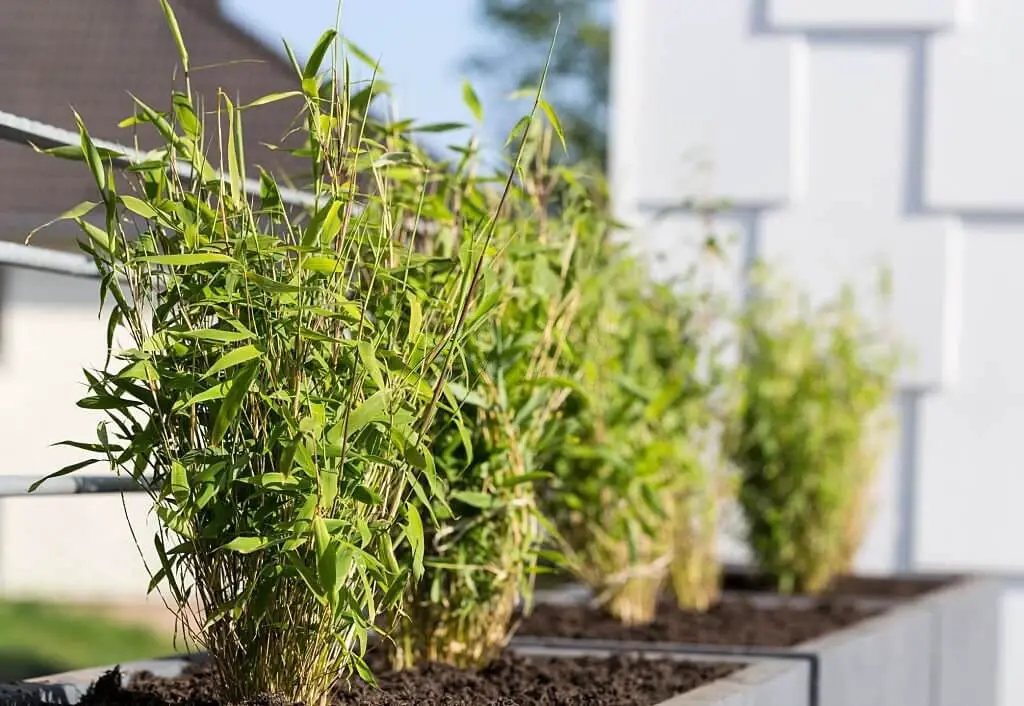
Umbrella Bamboo is a unique flowering plant that belongs to the Poaceae family and is native to western Sichuan Province in China. As part of the Fargesia genus, it joins around 30 other species of bamboo in its classification. This remarkable plant can grow up to 20-30 meters tall, with individual culms reaching diameters of up to 12 centimeters.
Notably, Umbrella Bamboo is a clumping variety, where new growth emerges from the rootstock rather than spreading across the ground like many other species. As the culms mature, they initially appear green but eventually transition to shades of yellow or brown.
How to grow bamboo plants
Growing bamboo plants is a popular choice for many garden enthusiasts, and it’s easy to see why. This versatile plant can serve as a privacy screen, windbreak, or simply add an ornamental touch to your outdoor space. However, with over 1000 species of bamboo to choose from, selecting the right one for your needs is crucial.
Before planting, it’s essential to identify the ideal location for your bamboo. Look for well-drained soil and full sun, although some species can tolerate partial shade.
Make sure to choose a spot that will give your bamboo room to grow, as some varieties can reach heights of over 100 feet.
Once you’ve found the perfect spot, it’s time to prepare the soil. Bamboo thrives in soil rich in organic matter, so if your soil is lacking, consider adding compost or manure to improve its quality.
After preparing the soil, it’s time to plant your bamboo. Spring is generally the best time to do this, after all danger of frost has passed.
When planting, dig a hole that’s twice as wide as the root ball and just as deep. Gently place the plant in the hole and backfill with soil, firming the soil around the base of the plant to remove any air pockets.
Water your bamboo plants regularly, especially during their first year after planting. Once established, most species are quite drought-tolerant, but extended periods of drought may require supplemental watering to keep them healthy.
How to care for bamboo
Bamboo’s unique charm can elevate any space, but it demands attention to thrive. To keep this versatile plant in top condition, heed these essential care tips.
Firstly, position bamboo in a spot that receives gentle indirect sunlight. Direct sunbeams can cause the leaves to yellow and eventually wilt.
Next, maintain consistent moisture levels by watering regularly – the soil should be damp but not waterlogged. While bamboo craves hydration, excessive moisture can be detrimental.
Fertilize your bamboo once a month during its growing season using a balanced fertilizer. This will promote healthy growth and prevent nutrient deficiencies.
Finally, prune your bamboo periodically to stimulate fresh growth and prevent it from becoming leggy and unruly.
FAQs about bamboo plants
What is the most popular type of bamboo?
While there are numerous types of bamboo, one stands out for its widespread popularity: Phyllostachys edulis, more commonly known as moso bamboo. Hailing from China and Japan, this towering species boasts an impressive stature – in fact, it’s the tallest type of bamboo globally, capable of reaching heights of up to 100 feet.
What type of bamboo does not spread?
While some types of bamboo are notorious for their invasive tendencies, there are also several species that are known for their controlled growth habits. These non-invasive bamboo varieties are often cultivated for ornamental purposes and include the Fargesia genus, which comprises approximately 60 different species. Additionally, Sasa veitchii and Pleioblastus chino are notable examples of clumping bamboo species that grow relatively slowly and do not spread via underground rhizomes.
What type of bamboo is good for privacy?
When it comes to using bamboo for privacy screens or hedges, it’s essential to consider the characteristics of different species. Some types of bamboo are well-suited for creating dense barriers that block out unwanted views, while others are better suited for adding visual interest to a landscape. The key is to choose a variety that meets your specific needs and goals.
One popular option for creating privacy screens is the Phyllostachys nigra, which can grow up to 20 feet tall and has thick stems that provide excellent coverage. This type of bamboo is ideal for creating a natural fence around your home or property. Alternatively, you might consider the Fargesia rufa, which reaches heights of up to 12 feet and has a more slender profile. When selecting the right bamboo for your privacy needs, it’s crucial to think about both the height and density of the plant.
If you’re looking for a solid barrier that will effectively block out nosy neighbors or prying eyes, opt for a taller variety with thicker stems. On the other hand, if you want to add some visual interest to your landscape without creating a dense screen, choose a shorter bamboo with thinner stalks. Regardless of which type of bamboo you choose, make sure to do your research and select a variety that meets your specific needs and goals.
Which bamboo grows the fastest?
While the growth rate of bamboo can vary significantly depending on the species, some types can exhibit remarkable speed. For instance, certain varieties can stretch an astonishing four feet in just 24 hours, while others may only incrementally add a few inches to their height. The champion among fast-growing bamboos is Dendrocalamus giganteus, which can burst forth at a rate of three feet per day, defying the conventional notion that plant growth occurs gradually over time.
What is the prettiest bamboo?
Bamboo’s natural diversity is a key aspect of its charm. With numerous species to choose from, each with its own distinct characteristics, it’s no wonder that people have strong preferences when it comes to the appearance of their bamboo. Some might be drawn to the elegant, slender stems of Phyllostachys bambusoides, while others might prefer the more robust, imposing presence of Dendrocalamus giganteus.
Ultimately, the perception of beauty in bamboo is a matter of personal taste, with different people appreciating different qualities in this versatile plant.
Conclusion
With 11 distinct types of bamboo plants at your disposal, creating an indoor oasis is merely a matter of finding the perfect specimen to match your unique style. Before making a purchase, take the time to learn about each variety, as some may require more maintenance or carry higher price tags than others. By taking the leap and providing proper care, you’ll be rewarded with a lush and vibrant indoor space that’s sure to turn heads.
Related Posts
Transforming your outdoor space with a diverse range of plants is just a few clicks away. Online plant nurseries offer an impressive variety of species to suit any climate or aesthetic. Whether you’re interested in cultivating the perfect orchard, pruning trees for a living, or developing new plant breeds, there’s a wealth of information available online. For those seeking a career in tree care, becoming an arborist is a fulfilling and challenging profession.
By mastering the skills necessary to prune, maintain, and diagnose tree health issues, you’ll be well-equipped to tackle even the most complex tree-related tasks. In addition to cultivating trees, plant breeding is another fascinating career path that allows you to create new and innovative plant species. By understanding the fundamental principles of plant reproduction and hybridization, you can develop unique varieties that thrive in a range of environments.
As the seasons change, so do our decorating needs. For autumn-themed container gardens, choose from a variety of annuals and perennials designed specifically for fall baskets. Foliage plants for dry, shady areas also provide a stunning solution for those challenging spaces. Finally, upright-growing plants offer vertical accents that add visual interest to any outdoor setting.



